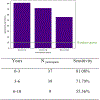Transfer learning for predicting conversion from mild cognitive impairment to dementia of Alzheimer's type based on a three-dimensional convolutional neural network
- PMID: 33422894
- PMCID: PMC7902477
- DOI: 10.1016/j.neurobiolaging.2020.12.005
Transfer learning for predicting conversion from mild cognitive impairment to dementia of Alzheimer's type based on a three-dimensional convolutional neural network
Abstract
Dementia of Alzheimer's type (DAT) is associated with devastating and irreversible cognitive decline. Predicting which patients with mild cognitive impairment (MCI) will progress to DAT is an ongoing challenge in the field. We developed a deep learning model to predict conversion from MCI to DAT. Structural magnetic resonance imaging scans were used as input to a 3-dimensional convolutional neural network. The 3-dimensional convolutional neural network was trained using transfer learning; in the source task, normal control and DAT scans were used to pretrain the model. This pretrained model was then retrained on the target task of classifying which MCI patients converted to DAT. Our model resulted in 82.4% classification accuracy at the target task, outperforming current models in the field. Next, we visualized brain regions that significantly contribute to the prediction of MCI conversion using an occlusion map approach. Contributory regions included the pons, amygdala, and hippocampus. Finally, we showed that the model's prediction value is significantly correlated with rates of change in clinical assessment scores, indicating that the model is able to predict an individual patient's future cognitive decline. This information, in conjunction with the identified anatomical features, will aid in building a personalized therapeutic strategy for individuals with MCI.
Keywords: Convolutional neural network; Dementia of Alzheimer's type; Magnetic resonance imaging; Mild cognitive impairment; Predictive modeling.
Crown Copyright © 2020. Published by Elsevier Inc. All rights reserved.
Conflict of interest statement
Disclosure Statement
This manuscript has nothing to disclose for actual or potential conflict and interest.
Figures







Similar articles
-
A parameter-efficient deep learning approach to predict conversion from mild cognitive impairment to Alzheimer's disease.Neuroimage. 2019 Apr 1;189:276-287. doi: 10.1016/j.neuroimage.2019.01.031. Epub 2019 Jan 14. Neuroimage. 2019. PMID: 30654174
-
A multi-model deep convolutional neural network for automatic hippocampus segmentation and classification in Alzheimer's disease.Neuroimage. 2020 Mar;208:116459. doi: 10.1016/j.neuroimage.2019.116459. Epub 2019 Dec 16. Neuroimage. 2020. PMID: 31837471
-
Estimating individual trajectories of structural and cognitive decline in mild cognitive impairment for early prediction of progression to dementia of the Alzheimer's type.Sci Rep. 2024 Jun 5;14(1):12906. doi: 10.1038/s41598-024-63301-7. Sci Rep. 2024. PMID: 38839800 Free PMC article.
-
Structural magnetic resonance imaging for the early diagnosis of dementia due to Alzheimer's disease in people with mild cognitive impairment.Cochrane Database Syst Rev. 2020 Mar 2;3(3):CD009628. doi: 10.1002/14651858.CD009628.pub2. Cochrane Database Syst Rev. 2020. PMID: 32119112 Free PMC article.
-
Machine learning methods for predicting progression from mild cognitive impairment to Alzheimer's disease dementia: a systematic review.Alzheimers Res Ther. 2021 Sep 28;13(1):162. doi: 10.1186/s13195-021-00900-w. Alzheimers Res Ther. 2021. PMID: 34583745 Free PMC article.
Cited by
-
The future of Alzheimer's disease risk prediction: a systematic review.Neurol Sci. 2025 Aug;46(8):3377-3390. doi: 10.1007/s10072-025-08167-x. Epub 2025 Apr 12. Neurol Sci. 2025. PMID: 40220257
-
A robust class decomposition-based approach for detecting Alzheimer's progression.Exp Biol Med (Maywood). 2023 Dec;248(24):2514-2525. doi: 10.1177/15353702231211880. Epub 2023 Dec 7. Exp Biol Med (Maywood). 2023. PMID: 38059336 Free PMC article.
-
Translating phenotypic prediction models from big to small anatomical MRI data using meta-matching.Imaging Neurosci (Camb). 2024 Aug 1;2:imag-2-00251. doi: 10.1162/imag_a_00251. eCollection 2024. Imaging Neurosci (Camb). 2024. PMID: 40800257 Free PMC article.
-
Diagnosis of early mild cognitive impairment using a multiobjective optimization algorithm based on T1-MRI data.Sci Rep. 2022 Jan 19;12(1):1020. doi: 10.1038/s41598-022-04943-3. Sci Rep. 2022. PMID: 35046444 Free PMC article.
-
Construction of a confounder-free clinical MRI dataset in the Mass General Brigham system for classification of Alzheimer's disease.Artif Intell Med. 2022 Jul;129:102309. doi: 10.1016/j.artmed.2022.102309. Epub 2022 Apr 27. Artif Intell Med. 2022. PMID: 35659387 Free PMC article.
References
-
- Alzheimer's Association. 2019 Alzheimer's disease facts and figures. Alzheimers Dement 2019;15(3):321–87. - PubMed
-
- Ardila D, Kiraly AP, Bharadwaj S, Choi B, Reicher JJ, Peng L, Tse D, Etemadi M, Ye W, Corrado G End-to-end lung cancer screening with three-dimensional deep learning on low-dose chest computed tomography. Nat Med 2019;25(6):954–61. - PubMed
-
- Ball M, Hachinski V, Fox A, Kirshen A, Fisman M, Blume W, Kral V, Fox H, Merskey H. A new definition of Alzheimer's disease: a hippocampal dementia. Lancet 1985;325(8419):14–6. - PubMed
Publication types
MeSH terms
Grants and funding
LinkOut - more resources
Full Text Sources
Other Literature Sources
Medical

